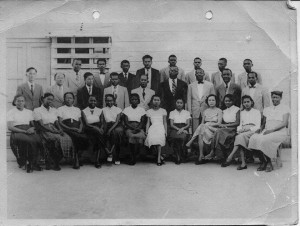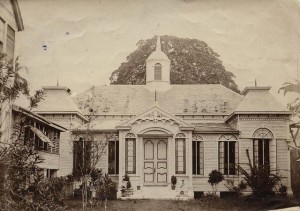
As “Education Month”, is being observed, we look back at the notable efforts of dedicated individuals who sought to ensure that all social classes have the right to equal academic opportunities.
Arrival of the missionaries
According to the Guyana Institute of Historical Research, the church was the largest private institution that contributed to the development of education, particularly at the primary level. The coming of the first missionary of the London Missionary Society (renamed the Congregational church) coincided with the abolition of the British participation in the African slave trade. During slavery, the missionaries concentrated on teaching the children of freed parents. Hermanus Post, a planter on the East Coast of Demerara had invited the London Missionary Society to send a missionary to his plantation at Le Resouvenir to instruct his slaves.
Rev. John Wray was the first missionary to work among the slaves. He arrived in Demerara in 1808. In 1813, Wray was asked by the commissioners of the crown estates, who had about 1100 African slaves under their care, to start the Berbice mission. But many of the Dutch planters were hostile to educating slaves.
During the early part of the 19th century, the other main missionary societies in Guiana were the Society for the Propagation of the Gospel; the Methodist Missionary Society; the Church Missionary Society, which worked specifically among the Amerindians from about 1827 to 1858, the Church of Scotland (Presbyterian); the Roman Catholic Church and the Moravians.
Rev. John Davies, a missionary of the London Missionary Society, had taught the “free children of Georgetown”. In 1810, he distributed copies of a small spelling book, called the “First Class Book”.
In 1824, there were two free schools – one for boys and the other for girls. It appears as if some churches gave aid to the free schools. In 1838, it was recorded in the minutes of the Kirk session of St. Andrews that a collection of 1,155 guilders was to be divided equally between the two free schools.
Rev. J. Bernau introduced the “normal” school idea to the Bartica community in 1835. He had a day and evening school, and later a boarding school-cum-orphanage.
Colonial support

In 1840, the Combined Court voted $2,000.00 for the education of Amerindians. It had to be shared equally among the missions on Pomeroon, Essequibo, Demerara, Corentyne, and Berbice. During the 1840s, the Combined Court vacillated over whether they should continue to support the denominational schools for the Amerindians.
Between 1835 and 1845, the imperial government voted money for the education of the masses under the “Negro Education Grant”. The government offered 30,000 pounds per annum for five years, and gradually reduced the grant each year until it ended in 1845. The missionary societies, who were involved with the ex-slaves, were the beneficiaries of the funding. The missionaries, like the Colonial Office, were concerned that the children of the masses were taught moral and religious education. Priority was not given to secondary education and teacher training.
Almost all of the schools established during the apprenticeship period began with classes in church buildings. The teachers were either the minister or his wife, a catechist, or in very rare cases, someone with some experience of teaching.
In order to solve the problem of the shortage of teachers, the missionaries sought to establish “Normal Schools” where teachers could be trained to satisfy local needs. The bible was used for all instruction.
After 1845, some of the missions were forced to close their schools because of inadequate funding. There was also a widespread feeling that the Africans should finance their own education. However, the churches, which continued in the field of education, were generally supported by their headquarters.
The Church’s role in education after emancipation
The Roman Catholics initially established schools for the Portuguese. In 1838, Dr. William Clancy, of the Roman Catholic Church, outlined his plan to send six ecclesiastics, three school masters and three school mistresses, for educating the population, and also to construct three school buildings in each county. By 1841, six nuns of the Sisters of Presentation arrived in the colony to open a day school and a boarding school.
In 1847, the Ursuline Convent School was established. By 1866, the Roman Catholic Church established St. Stanislaus College boys’ schools. In 1897, the St. Joseph High school for girls was established by the Sisters of Mercy.
The Anglican Church also participated in the field of education. In 1824, the St. George’s free school was established, under the aegis of the Anglican Church. The school was conducted separately for boys and girls. Another Anglican school, All Saints was established in New Amsterdam, Berbice, in 1829.
In 1851, Bishop’s College was launched with the support of the S.P.C.K. It was established for the training of theological students and the general training of teachers. The Methodists, Presbyterians, and the Anglicans established schools for the Indians.
The planter Quintin Hogg supported the Anglican Church in the erection of a series of buildings of a chapel-school combination in Essequibo and Demerara. One such chapel-school building was erected at Bel Air, on the East Coast of Demerara in 1873.
“The school-house is built then to make you happy – to teach you to love God because He is your Father. I have and want you to listen every Sunday at 2 o’clock there will be school for the children. At 3 o’clock, there will be Service for the adults. Every day there will be school for the children, and every Monday, at Half-past four, there will be a class for instruction in reading and writing in Hindustan and English,” Quintin Hogg is said to have commented.
Apart from the training institutes, estates’ schools, parochial schools and the orphan asylum, there were also private nursery schools, and special evening schools both in Demerara and Berbice.
There were evening or night schools at Nismes on the West Bank of Demerara, at Lusignan, Annandale, Enmore and Clonbrook. In addition, Indian immigrants received instruction at the Kingston Coolie School, and at the Church of Scotland at Lochaber in Berbice.
Other religious groups, the abandonment and reestablishment of private education
By the second half of the 20th century, there were private individuals who established high schools for the poorer classes. The Muslims and Hindus also established schools. (Guyana Times Sunday Magazine)



